Replacing the Motor or the Gearbox on the Main Axis
The use and application of the information contained herein require expertise in the design and programming of automated control systems. Only you, the user, machine builder or integrator, can be aware of all the conditions and factors present during installation and setup, operation, repair, and maintenance of the machine or process.
You must also consider any applicable standards and/or regulations with respect to grounding of all equipment. Verify compliance with any safety information, different electrical requirements, and normative standards that apply to your machine or process in the use of this equipment.
|
|
|
HAZARD OF ELECTRIC SHOCK, EXPLOSION, OR ARC FLASH |
|
oDisconnect all power from all equipment including connected devices prior to removing any covers or doors, or installing or removing any accessories, hardware, cables, or wires. oPlace a "Do Not Turn On" or equivalent hazard label on all power switches and lock them in the non-energized position. oWait 15 minutes to allow the residual energy of the DC bus capacitors to discharge. oMeasure the voltage on the DC bus with a properly rated voltage sensing device and verify that the voltage is less than 42.4 Vdc. oDo not assume that the DC bus is voltage-free when the DC bus LED is off. oBlock the motor shaft to prevent rotation prior to performing any type of work on the drive system. oDo not create a short-circuit across the DC bus terminals or the DC bus capacitors. oReplace and secure all covers, accessories, hardware, cables, and wires and confirm that a proper ground connection exists before applying power to the unit. oUse only the specified voltage when operating this equipment and any associated products. |
|
Failure to follow these instructions will result in death or serious injury. |
Perform the following procedures to replace the motor or the gearbox on the main axis:
oRemoving the motor and the gearbox
oRemoving the motor from the gearbox
oMounting the new motor and/or the new gearbox
oCabling the motor and the gearbox
Removing the Motor and the Gearbox
Certain variants have a protective motor cover in place that must be removed. The motor cover is heavy (approximately 5 kg (11 lb)), and could cause damage or injury if it were to fall during removal.
|
|
|
FALLING HEAVY LOAD |
|
Support the motor and gearbox while removing. |
|
Failure to follow these instructions can result in death, serious injury, or equipment damage. |
|
|
|
FALLING MOTOR COVER |
|
Hold the motor cover in place while loosening the screws. |
|
Failure to follow these instructions can result in injury or equipment damage. |
|
Step |
Action |
|---|---|
|
1 |
Remove the upper arm as described in Replacing the Upper Arms. |
|
2 |
Loosen the four threaded rods (1) at the rear end of the motor cover. 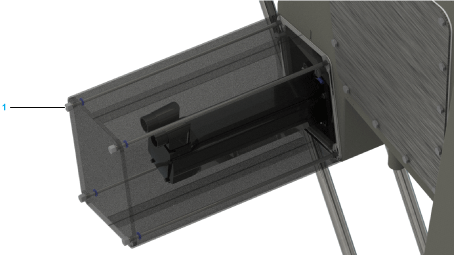
|
|
3 |
Lift the motor cover slightly and remove to the rear. 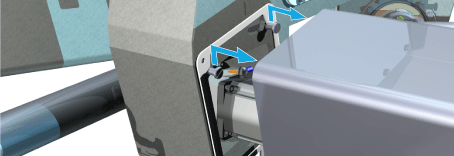
|
|
4 |
oFor robots with an SH3 motor (VRKP•S): Disconnect and remove the two motor supply cables. oFor robots with an ILM motor (VRKP•L): Lift up the locking device slightly of the hybrid cable and then remove the cable. |
|
5 |
Remove the hexagon cap (1) from the ground connection at the motor. 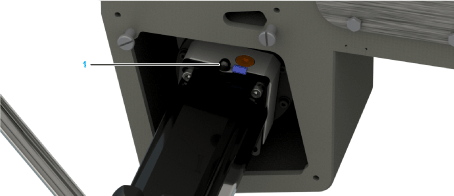
|
|
6 |
Disconnect and remove the ground cable from the motor. |
|
7 |
Remove the bolts (1) by means of which the gearbox is bolted to the robot housing. 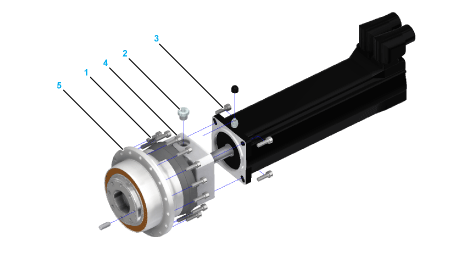
|
|
8 |
Carefully remove the motor and the gearbox (5) from the housing in rearward direction. NOTE: To prevent a damage of the precision hole in the robot housing, do not tilt the gearbox. |
Removing the Motor from the Gearbox
|
Step |
Action |
|---|---|
|
1 |
Remove the plug screw (2) on the gearbox flange. 
|
|
2 |
Remove the four screws (3) on the motor which connect the motor to the gearbox. |
|
3 |
Carefully rotate the motor until the screw (4) on the clamping flange appears in the aperture of the plug screw. |
|
4 |
Loosen this screw. |
|
5 |
Carefully remove the motor from the gearbox. |
Mounting the New Motor and/or the New Gearbox
|
Step |
Action |
|---|---|
|
1 |
Ensure that the gearbox and the housing are at the same temperature, as otherwise - in the case of a temperature difference - the gearbox may not fit into the aperture provided. |
|
2 |
Attach the motor to the gearbox according to the specifications of the manufacturer: oTightening torque of the clamping hub: oFor VRKP0 / VRKP1: 5 Nm (44 lbf-in) oFor VRKP2 / VRKP4 / VRKP5 / VRKP6: 9.5 Nm (84 lbf-in) oTightening torque of the motor screws: 3.5 Nm (31 lbf-in) NOTE: Position the motor and the gearbox vertically during mounting if possible. |
|
3 |
Insert the plug screw into the gearbox flange. |
|
4 |
Attach the motor/gearbox combination in the orientation specified to the robot housing. Tightening torque: oFor VRKP0 / VRKP1: 3 Nm (26 lbf-in) oFor VRKP2 / VRKP4 / VRKP5 / VRKP6: 4.7 Nm (42 lbf-in) For further information, refer to the detail drawing in Mechanical and Electrical Data. |
|
NOTICE |
|
DISTORTION OF MOTOR AND GEARBOX |
|
Only fasten motor and gearbox with all components at the same ambient temperature. |
|
Failure to follow these instructions can result in equipment damage. |
Cabling the Motor and the Gearbox
|
Step |
Action |
|---|---|
|
1 |
Attach the ground strap to the motor. Tightening torque: 2.5 Nm (22 lbf-in) NOTE: When routing the cables, ensure that the grounding cap remains on the ground connection of the motors. The motor supply cable may become damaged by the thread of the ground strap attachment. |
|
2 |
Put the hexagon cap on the ground connection at the motor. For further information, observe the respective operating instructions of the motors: oVRKP2S0 / VRKP4S0 / VRKP5S0 / VRKP6S0: SH3 Servo motor Motor Manual oVRKP2L0 / VRKP4L0 / VRKP5L0 / VRKP6L0: Lexium 62 ILM Hardware Guide |
|
3 |
Attach the motor supply cables and lock them in position. |
|
4 |
Attach a new seal (quad ring) on the front between gearbox and housing by exercising light pressure to press the seal between the housing and the gearbox. NOTE: Do not use any sharp-edged tools so as not to damage the seal. |
|
5 |
Verify that the seal (1) does not stand out over the gearbox or the housing. 
|
|
6 |
When using a new gearbox: Mount the threaded pin (3) as otherwise it may not be possible to mount the upper arm. For further information, refer to the detail drawing in Mechanical and Electrical Data. |
|
7 |
Mount the upper arm as described in Replacing the Upper Arms. |
|
8 |
|
|
|
ELECTRIC SHOCK DUE TO DAMAGED CABLES |
|
Verify that the grounding cap is placed correctly on the grounding connection of the motor. |
|
Failure to follow these instructions will result in death or serious injury. |
|
NOTICE |
|
COLLISION OF COMPONENTS |
|
Calibrate the robot mechanics after the replacement of an upper arm, a motor, or a gearbox. |
|
Failure to follow these instructions can result in equipment damage. |
|
Step |
Action |
|---|---|
|
1 |
Attach a new seal (1) on the capture screws (3) for the motor cover (4), as the old seal may cause leakages to occur between the housing and the motor cover. 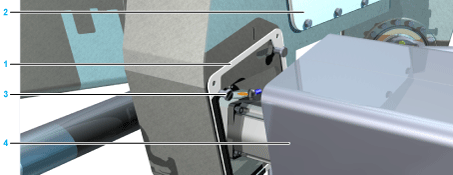
|
|
2 |
Verify the position of the captive washers (1). The captive washers should be located in the rear of the motor cover (2) on the threaded rods (3). NOTE: The captive washers should be placed so that the threaded rods can not drop out from the aperture of the motor cover (4). 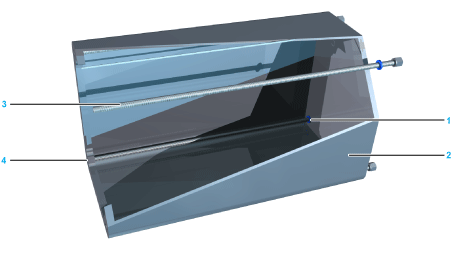
|
|
3 |
Correct the position of the captive washers on the threaded rod if necessary. |
|
4 |
Verify whether any open cables exist and remove them, if any. |
|
5 |
Hook the motor cover on the capture screws and tighten the four threaded rods at the motor cover. Tightening torque: 6 Nm (53.1 lbf-in) |
|
6 |
Mount the telescopic axis and the lower arms. For further information, refer to Replacing the Telescopic Axis and Mounting the Lower Arms. |